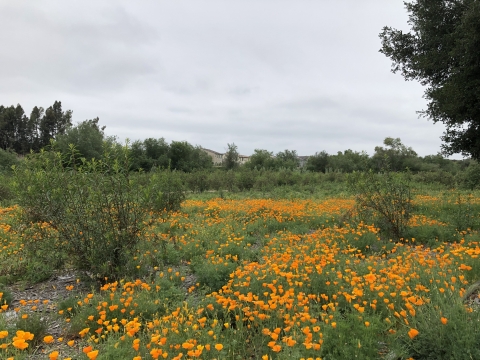The abandoned golf course at Moosa Creek was an eyesore in the community of Bonsall, Calif. What was once a recreational hotspot had become a 67-acre junkyard of dilapidated bridges, defunct tennis courts, and overgrown vegetation. The site was creating a fire risk for residents.
But Katy Kughen, wildlife biologist with the Carlsbad Fish and Wildlife Office, saw the course through a different lens. She had visited about a half-dozen sites in search of land to restore when she discovered Moosa Creek, just a few miles from U.S. Marine Corps Air Station Camp Pendleton.
“It’s really rare to find a site in Southern California where you can do riparian riparian
Definition of riparian habitat or riparian areas.
Learn more about riparian habitat restoration on this scale. Usually, you find one or two acres, but this was a site where we could do habitat creation—not just enhancement—but creation of habitat,” Kughen says.
The Service was working with MCAS Camp Pendleton on a plan to remove native riparian habitat, including large trees that caused a potential flight hazard for the military installation’s runway. Removing the habitat was also part of a future project to repair the levee that surrounds the installation. But the trees and surrounding grasslands were habitat for the endangered arroyo toad, least Bell’s vireo, and southwestern willow flycatcher, so the Service and the camp devised a way to meet Department of Defense airfield safety standards and conduct the levee repairs while offsetting impacts to the protected toad and birds.
The Endangered Species Act directs all federal agencies to participate in conserving protected species. Agencies must consult with the Service when any project or action they authorize, fund, or carry out may affect a protected species or its designated critical habitat.
MCAS Camp Pendleton is no stranger to natural resource management. Its location within a flood plain terrace for the Santa Margarita River and its status as a landowner within the larger Marine Corps Base Camp Pendleton have made it a unique blend of undeveloped native habitat and advanced aviation technology. Within its footprint, it supports riparian scrublands and woodlands, native grasslands and forblands, a freshwater wetland, and mowed grasslands along the flightline, providing a home for three federally protected species and several California bird and amphibian species of Special Concern.
The Marines needed a commensurate amount of land to mitigate the habitat loss on the air station, and Kughen had the perfect recommendation: Moosa Creek golf course.
The air station partnered with Burns & McDonnell, a firm specializing in environmental mitigation solutions, to first obtain landowner permissions for the 67 acres, and then design and implement a riparian restoration project across the site. The Marines provided funding.
“MCAS Camp Pendleton continually demonstrates its value of local biodiversity and is one of our most important partners in protecting it,” Kughen says. “We’re proud to work with such a committed group of visionaries at the air station and Burns & McDonnell to harmonize wildlife conservation with infrastructure needs.”
The restoration site was historically within the floodplain of the San Luis Rey River but was highly degraded and Moosa Creek was confined to a single channel.
Engineers worked to improve the hydrological function of the creek, reactivate the floodplain, and extend the habitat corridor essential to species living there.
Restoration specialists recontoured the area using 70,000 yards of on-site soil and established more than 50,000 native plants and trees, including Fremont cottonwood, California sycamore, coast live oak, blue elderberry, willows, and mule fat, sourced from on-site tree branch cuttings and a local nursery to restore the natural ecosystem. Now that implementation is complete, Burns & McDonnell will continue to work with the Service as the site meets performance objectives over the next several years.
“We are honored to join the Marine Corps and U.S. Fish and Wildlife Service in protecting natural resources through cost-effective and efficient solutions,” says Paul Sherman, Burns & McDonnell project manager. “This project was designed to span the course of decades, mitigating impacts to endangered species and improving our environment.”
MCAS Camp Pendleton replaced the trees at the end of its runway with low-growing native grasses and forbs that will continue to provide foraging and sheltering habitat for the toads. And the vireos and flycatchers will continue to use the remaining riparian habitat on the installation for foraging and nesting.
“The success of this restoration project is due to the triumvirate, and we are extremely proud to be part of the team with the Service and Burns & McDonnell to solve the aviation safety issue while supporting endangered species for our community,” said Col. David B. Moore, commanding officer, MCAS Camp Pendleton.
The revegetation portion of the Moosa Creek Restoration Project was completed this summer, and as the vegetation matures, it will provide a beautiful view with environmental benefits for both people and wildlife.





